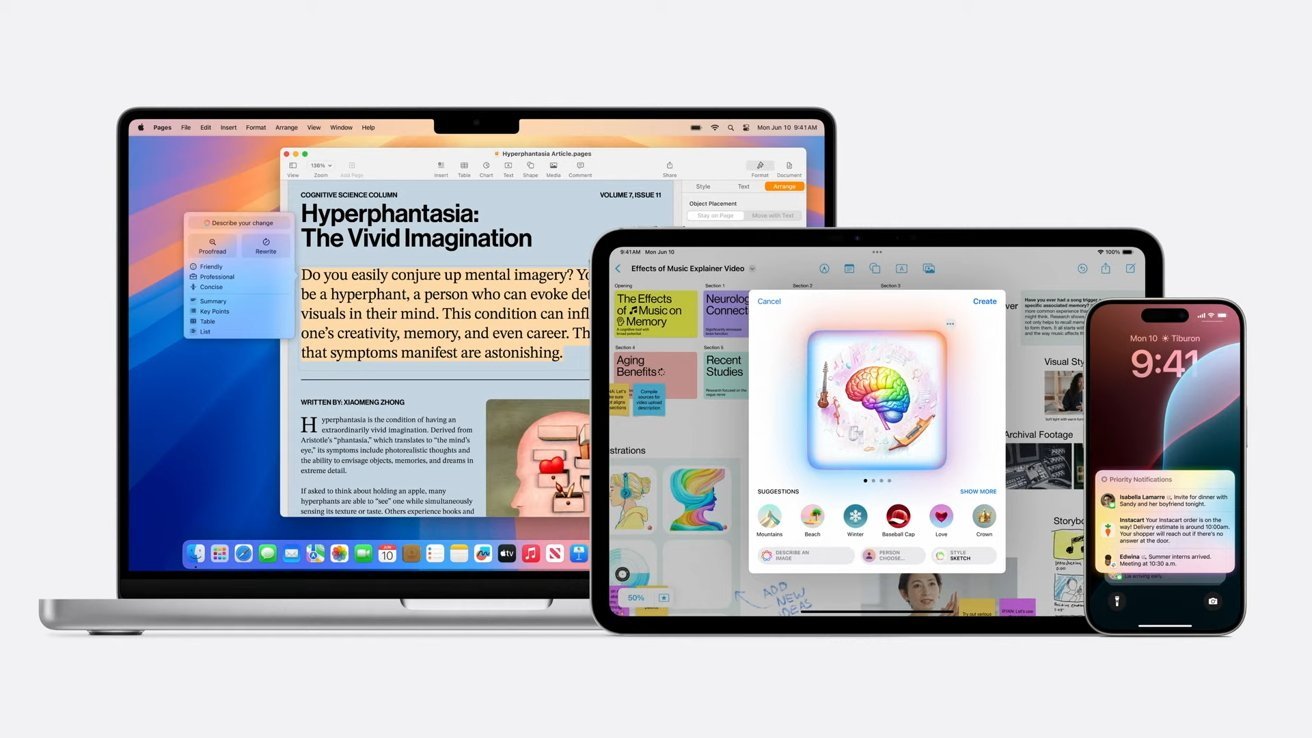
Examples of Apple Intelligence at work.

Developer beta testers are finally able to try out Apple Intelligence on their iPhone and other devices, as part of the first betas of iOS 18.1, iPadOS 18.1, and macOS Sequoia 15.1.
For the introduction of Apple’s updates to iOS 18, iPadOS 18, and macOS Sequoia at WWDC, the most-awaited change was the introduction of Apple Intelligence. While it hasn’t been available to test in first-generation developer betas so far, Apple has finally made the machine learning update usable by developers.
The first beta of iOS 18.1, iPadOS 18.1, and macOS Sequoia 15.1 are being made available today, which will include access to Apple Intelligence features. The beta exists alongside the betas for iOS 18, iOS 18, macOS Sequoia 15, and their counterparts.
What is Apple Intelligence?
Apple Intelligence is Apple’s push into generative AI. This includes the use of large language models (LLMs) to perform various tasks involving text, images, and in-app actions.
For example, it can be used to help iPhone users write better emails to others, with tools to help proofread text, rewrite it, or to adjust the tone. These changes can be performed using a number of different styles, such as making it more professional in tone for work-related messages.
It is also helping fuel some of the changes in Photos, allowing for users to quickly find images with Siri using natural language prompts.
Apple Intelligence can also generate images from scratch, with Genmoji creating the cartoony icons for message based on prompts.
Image Playground can also let users combine concepts to create an image in a few different styles. It also comes into play in apps, with users able to insert a generated image of their own description.
It’s also possible for the generated image to be created based on the context of existing document elements, to make it more appropriate in relation to the text. As an example, a report on France could create an image featuring the Eiffel Tower.
Apple Intelligence will also make a difference to Siri, as it is capable of improving the responses given to users. Along with more natural conversations, Siri will also take into account context and relationships, capitalizing on data from other apps to make associations between people, times, places, and subjects.
The iOS 18.1 and iPadOS 18.1 developer betas are build number 22B5007p. The first macOS Sequoia developer beta is build 24B5009l.
What’s coming in the beta
The iteration of Apple Intelligence in the iOS 18.1 and macOS 15.1 developer beta will be usable if you have the Siri language set to English and the region set to U.S. Developers should get access within hours of availability, but wait times may vary.
The features available in the initial release include the writing tools, priority messages, email summaries, and email smart replies. There will be auto summarization of texts and emails on the Lock Screen, and summaries for transcriptions. Natural-language search will also be available for photos and videos.
Siri will also have some functionality powered by Apple Intelligence, though ChatGPT integration will have to wait until later in 2024.
Not for everyone
While a major change for Apple’s operating systems, not every user will gain access to Apple Intelligence at launch.
For a start, it will require the use of Apple Silicon Mac models, Apple Silicon iPad models, the iPhone 15 Pro, and iPhone 15 Pro Max. As future models roll out with better specifications, they too will be able to use Apple Intelligence.
Apple has also said that it probably won’t be bringing the final release of Apple Intelligence and some other features to devices in the EU. It has claimed that the interoperability requirements of the Digital Markets Act could “compromise the integrity” of its products, in terms of privacy and security.
Apple’s June statement isn’t a good sign for EU-based users, but it’s not definitively saying Apple Intelligence won’t come to the EU at all. Cupertino has said it is committed to working with the European Commission in an “attempt to find a solution” to Apple’s regulatory concerns.
While it is also expected to be introduced as part of the developer betas, it remains to be seen whether it will rapidly be included in the public beta track shortly after it becomes available. There’s a chance it could be a developer-only feature for a few betas rounds, at least until it’s found to be working adequately enough for consumers.
There is also the concern that not every feature of Apple Intelligence will be available in the fall. Some features, including its revamp of Siri, may not necessarily be ready for the fall arrival.
Contextual answers may also end up being delayed into 2025.
Apple is also building its Private Compute Cloud facilities, which requires a lot of infrastructure changes. That may too impact its secure off-site processing capabilities.




